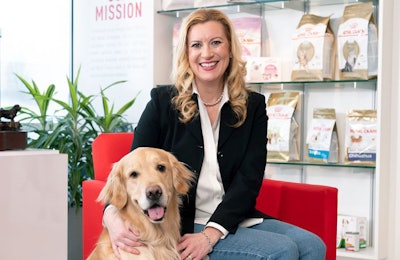
Kamie Eckert, president of Mars-owned Royal Canin’s United States division, spoke with Tim Wall, staff reporter for Petfood Industry. She discussed how Royal Canin avoids following pet food consumer trends and instead focuses on nutritional needs specific to breeds and conditions.
Wall: Here in the U.S., there have been some pet food trends that seem to be a cart-leading-the-horse kind of thing, where trends aren’t based in empirical evidence. Could you talk about how Royal Canin avoids being sucked into the latest hype?
Eckert: I can, and sometimes it’s not easy. I will start by saying that because it is often hard to have the conversation around nutrition when there are a lot of fads that are happening out there. I think what we always go back to is the diets that we carry, and that we are constantly working on from an R and D standpoint, are to benefit healthy outcomes in pets.
We really look at what that need is and how we formulate the diet from a nutrient profile that gives those healthy outcomes to pets. I think that is what differentiates us, because that is such a cornerstone for us. Even when it’s not popular and even when it’s challenging with your customers or your pet owners to have some of those conversations. What it does, is it ensures that we are authentic and committed to the pets that we serve in a way that is, I think, just above and beyond in this industry from a commitment standpoint.
So, we are sometimes a little bit stubborn in that, but it’s always with the best intention around the healthy outcomes for pets.
Wall: Have you gotten feedback or flak from consumers asking why you are not offering a particular on-trend diet?
Eckert: We do, and I think that one of the things that’s — an interesting part of our diets is that when you look at them, they really are very much natural and I think that’s an interesting word in this time and space. But we really use ingredients that are nutritional, and we are focused on how they benefit the individual pet. So, we do get flak saying, “Well, we want this or we want that”, but we don’t even create diets for pets that don’t have specific needs.
As an example, if you have a Husky, they don’t have any needs that are different than another large size dog. On the other hand, if you have a Golden Retriever, they do have issues. They have ear infections and hot spots and a lot of different things like that, so as a result, we don’t make a Husky food although they eat a lot but we do make a Golden Retriever food because it addresses a specific need. That’s the piece we go back to is that our commitment is to the pets first and that’s reason we design our diets the way we do.














